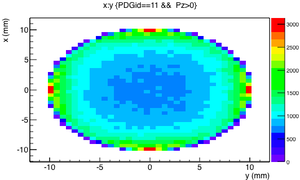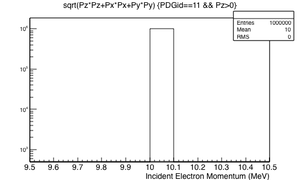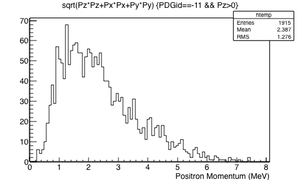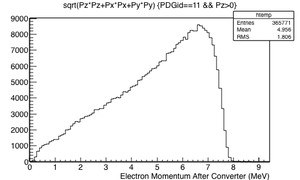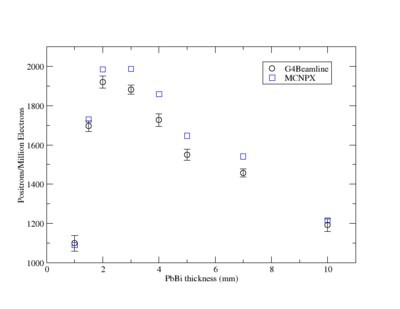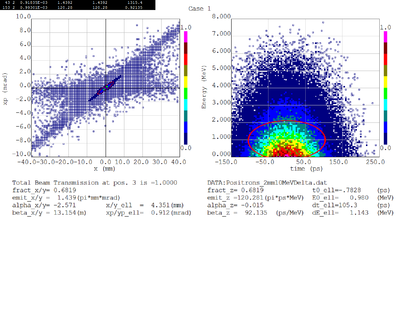Difference between revisions of "Niowave 10-2015"
| Line 6: | Line 6: | ||
Incident Electron spatial distribution and energy | Incident Electron spatial distribution and energy | ||
| − | [[File:PbBi_5-1-15_X-Yposition.png | | + | [[File:PbBi_5-1-15_X-Yposition.png | 300 px]][[File:PbBi_5-1-15_Ein.png | 300 px]] |
Positron and Electron Momentum after the converter | Positron and Electron Momentum after the converter | ||
| − | [[File:PbBi_5-1-15_Ppositron.png | | + | [[File:PbBi_5-1-15_Ppositron.png | 300 px]][[File:PbBi_5-1-15_Pelectron.png | 300 px]] |
| Line 16: | Line 16: | ||
| − | Text files were delivered to Niowave so Niowave could begin designing a beamline to transport the positrons using a solenoid immediately downstream of the PbBi target. Dmitry, from Niowave, used the test files to calculate the beam transport properties of the positrons escaping the PbBi target. | + | Text files were delivered to Niowave so Niowave could begin designing a beamline to transport the positrons using a solenoid immediately downstream of the PbBi target. Dmitry, from Niowave, used the test files to calculate the beam transport properties of the positrons escaping the PbBi target. The phase space properties for the core positron distribution (68.2%) are shown below as well as their temporal distribution. |
| − | |||
| − | |||
| − | |||
| − | |||
| − | |||
| − | |||
| − | |||
| − | |||
| − | |||
| − | |||
| − | |||
| − | |||
| − | |||
| − | |||
| − | |||
| − | |||
[[File:Pd2.png| 400 px]] | [[File:Pd2.png| 400 px]] | ||
Revision as of 14:52, 13 April 2016
Niowave Positron Project Progress for October 2015
A comparison was made between MCNPX and GEANT4 using a cylindrical electron beam with a radius of 1 cm. The 10 MeV incident electrons impinged a 2 mm thick PbBi target. Positrons escape the surface of the PbBi target with a mean momentum of 2.3 MeV. The positron production efficiency predictions from MCNPX and GEANT4 are within uncertainties.
Incident Electron spatial distribution and energy
Positron and Electron Momentum after the converter
Text files were delivered to Niowave so Niowave could begin designing a beamline to transport the positrons using a solenoid immediately downstream of the PbBi target. Dmitry, from Niowave, used the test files to calculate the beam transport properties of the positrons escaping the PbBi target. The phase space properties for the core positron distribution (68.2%) are shown below as well as their temporal distribution.
